How to Close the Gap of Desalinated Seawater for Agricultural Irrigation? Confronting Attitudes between Managers and Farmers in Alicante and Murcia (Spain)
Abstract
1. Introduction
2. Materials and Methods
2.1. Questionnaire Design
2.2. Survey Methodology
2.3. Data Analysis
3. Case Study
3.1. Location
3.2. The Tajo-Segura Transfer
3.3. Desalination Plants
3.4. Irrigation Communities
4. Results
4.1. Desalination Management
4.1.1. Water Concessions
4.1.2. Services and Management Developed by ACUAMED
4.1.3. Regulation
4.2. Desalination Water Use
4.2.1. Motivation, Demand and Use
4.2.2. Water Price, Tax and Cost
4.2.3. Water Quality Standards
4.3. Future Outlook
4.3.1. Benefits and Impacts
4.3.2. Future Scenarios
5. Discussion
6. Conclusions
Author Contributions
Funding
Acknowledgments
Conflicts of Interest
References
- Bertule, M.; Glennie, P.; Bjornsen, P.K.; Lloyd, G.J.; Kjellen, M.; Dalton, J.; Rieu-Clarke, A.; Romano, O.; Tropp, H.; Newton, J.; et al. Monitoring water resources governance progress globally: Experiences from monitoring SDG indicator 6.5.1. On Integrated Water Resources Management implementation. Water 2018, 10, 1744. [Google Scholar] [CrossRef]
- Azhoni, A.; Jude, S.; Holman, I. Adapting to climate change by water management organisations: Enablers and barriers. J. Hydrol. 2018, 559, 736–748. [Google Scholar] [CrossRef]
- Aparicio, J.; Candela, L.; Alfranca, O. Social and private costs of water for irrigation: The small desalination plant in San Vicente del Raspeig, Spain. Desalination 2018, 439, 102–105. [Google Scholar] [CrossRef]
- Arahuetes, A.; Hernández, M.; Rico, A.M. Adaptation strategies of the hydrosocial cycles in the Mediterranean region. Water 2018, 10, 790. [Google Scholar] [CrossRef]
- Ricart, S.; Rico, A.M. Assessing technical and social driving factors of water reuse in agriculture: A review on risks, regulation and the yuck factor. Agric. Water Manag. 2019, 217, 426–439. [Google Scholar] [CrossRef]
- Kaner, A.; Tripler, E.; Hadas, E.; Ben-Gala, A. Feasibility of desalination as an alternative to irrigation with water high in salts. Desalination 2017, 416, 122–128. [Google Scholar] [CrossRef]
- Shin, H.; Kalista, B.; Jeong, S.; Jang, A. Optimization of simplified freeze desalination with surface scraped freeze crystallizer for producing irrigation water without seeding. Desalination 2019, 452, 68–74. [Google Scholar] [CrossRef]
- Camarasa-Belmonte, A.M.; Rubio-Vila, M.; Salas-Rey, J. Evolución de episodios pluviométricos en la Demarcación Hidrográfica del Júcar (1989–2016): Del recurso al riesgo. Investig. Geográficas 2020. [Google Scholar] [CrossRef]
- Jones, J.; Qadir, M.; van Vliet, M.T.H.; Smakhtin, V.; mu Kang, S. The state of desalination and brine production: A global outlook. Sci. Total Environ. 2019, 657, 1343–1356. [Google Scholar] [CrossRef] [PubMed]
- Gao, L.; Yoshikawa, S.; Iseri, Y.; Fujimori, S.; Kanae, S. An economic assessment of the global potential for seawater desalination to 2050. Water 2017, 9, 763. [Google Scholar] [CrossRef]
- Jia, X.; Klemes, J.J.; Varbanov, P.S.; Alwi, S.R.W. Analyzing the energy consumption, GHG emission, and cost of seawater desalination in China. Energies 2019, 12, 463. [Google Scholar] [CrossRef]
- Russo, D.; Kurthman, D. Using desalinated water for irrigation: Its effect on field scale water flow and contaminant transport under cropped conditions. Water 2019, 11, 687. [Google Scholar] [CrossRef]
- Attarde, D.; Jain, M.; Singh, P.K.; Gupta, S.K. Energy-efficient seawater desalination and wastewater treatment using osmotically driven membrane processes. Desalination 2017, 413, 86–100. [Google Scholar] [CrossRef]
- Arahuetes, A.; Villar, R. Desalination, a strategic and controversial resource in Spain. WIT Trans. Ecol. Environ. 2017, 216, 61–72. [Google Scholar] [CrossRef]
- Barron, O.; Ali, R.; Hodgson, G.; Smith, D.; Qureshi, E.; McFarlane, D.; Campos, E.; Zarzo, D. Feasibility assessment of desalination application in Australian traditional agriculture. Desalination 2015, 364, 33–45. [Google Scholar] [CrossRef]
- Dawoud, J.M.; Al Mulla, M. Environmental impacts of seawater desalination: Arabian Gulf case study. Int. J. Environ. Sustain. Dev. 2012, 1, 22–37. [Google Scholar] [CrossRef]
- Serrano-Tovar, T.; Peñate Suárez, B.; Musicki, A.; de la Fuente Bencomo, J.A.; Cabello, V.; Giampietro, M. Structuring an integrated water-energy-food nexus assessment of a local wind energy desalination system for irrigation. Sci. Total Environ. 2019, 689, 945–957. [Google Scholar] [CrossRef]
- Nayar, K.G.; Lienhard, J.H. Brackish water desalination for greenhouse agriculture: Comparing the costs of RO, CCRO, EDR, and monovalent-selective EDR. Desalination 2020, 475, 114188. [Google Scholar] [CrossRef]
- Martínez-Álvarez, V.; Martín-Gorriz, B.; Soto García, M. Seawater desalination for crop irrigation. A review of current experiences and revealed key issues. Desalination 2016, 381, 58–70. [Google Scholar] [CrossRef]
- Hu, Y.; Lindo-Atichati, D. Experimental equations of seawater salinity and desalination capacity to assess seawater irrigation. Sci. Total Environ. 2019, 651, 807–812. [Google Scholar] [CrossRef]
- Zhang, Y.; Wang, R.; Huang, P.; Wang, X.; Wang, S. Risk evaluation of large-scale seawater desalination projects based on an integrated fuzzy comprehensive evaluation and analytic hierarchy process method. Desalination 2020, 478, 114286. [Google Scholar] [CrossRef]
- Ghermandi, A.; Minich, T. Analysis of farmers’ attitude toward irrigation with desalinated brackish water in Israel’s Arava Valley. Desalin. Water Treat. 2017, 76, 328–331. [Google Scholar] [CrossRef]
- Shaffer, D.L.; Yin Yip, N.; Gilron, J.; Elimelech, M. Seawater desalination for agriculture by integrated forward and reverse osmosis: Improved product water quality for potentially less energy. J. Membr. Sci. 2012, 415–416, 1–8. [Google Scholar] [CrossRef]
- Aznar-Sánchez, J.A.; Belmonte-Ureña, L.J.; Valera, D.L. Perceptions and acceptance of desalinated seawater for irrigation: A case study in the Níjar District (Southeast Spain). Water 2017, 9, 408. [Google Scholar] [CrossRef]
- Roberts, D.A.; Johnston, E.L.; Knott, N.A. Impacts of desalination plant discharges on the marine environment: A critical review of published studies. Water Res. 2010, 44, 5117–5128. [Google Scholar] [CrossRef] [PubMed]
- De-la-Ossa-Carretero, J.A.; Del-Pilar-Ruso, Y.; Loya-Fernández, A.; Ferrero-Vicente, L.M.; Marco-Méndez, C.; Martinez-Garcia, E.; Giménez-Casalduero, F.; Sánchez-Lizaso, J.L. Bioindicators as metrics for environmental monitoring of desalination plant discharges. Mar. Pollut. Bull. 2016, 103, 313–318. [Google Scholar] [CrossRef]
- Sola, I.; Sánchez-Lizaso, J.L.; Muñoz, P.T.; García-Bartolomei, E.; Sáez, C.A.; Zarzo, D. Assessment of the requirements within the environmental monitoring plans used to evaluate the environmental impacts of desalination plants in Chile. Water 2019, 11, 2085. [Google Scholar] [CrossRef]
- Berbel, J.; Gutiérrez-Martín, C.; Rodríguez-Díaz, J.A.; Camacho, E.; Montesinos, P. Literature review on rebound effect of water saving measures and analysis of a Spanish case study. Water Resour. Manag. 2015, 29, 663–678. [Google Scholar] [CrossRef]
- Albiac, J.; Esteban, E.; Tapia, J.; Rivas, E. Water scarcity and droughts in Spain: Impacts and policy measures. In Drought in Arid and Semi-Arid Regions. A Multi-Disciplinary and Cross-Country Perspective; Schwabe, K., Albiac, J., Connor, J.D., Hassan, R.M., Gonzalez, L.M., Eds.; Springer: Berlin/Heidelberg, Germany, 2013; pp. 323–338. [Google Scholar] [CrossRef]
- March, H.; Saurí, D.; Rico, A.M. The end of scarcity? Water desalination as the new cornucopia for Mediterranean Spain. J. Hydrol. 2014, 519, 2642–2651. [Google Scholar] [CrossRef]
- Morote, A.F. La desalinización. De recurso cuestionado a recurso necesario y estratégico durante situaciones de sequía para los abastecimientos en la Demarcación Hidrográfica del Segura. Investig. Geográficas 2018, 70, 47–69. [Google Scholar] [CrossRef]
- Hernández-Sánchez, J.C.; Boluda-Botella, N.; Sánchez Lizaso, J.L. The role of desalination in water management in southeast Spain. Desalin. Water Treat. 2017, 76, 71–76. [Google Scholar] [CrossRef]
- Del Villar, A. El coste energético de la desalinización en el Programa AGUA. Investig. Geográficas 2014, 64, 101–112. [Google Scholar] [CrossRef]
- García-Rubio, M.A.; Guardiola, J. Desalination in Spain: A growing alternative for water supply. Int. J. Water Resour. D 2012, 28, 171–186. [Google Scholar] [CrossRef]
- Navarro, T. Water reuse and desalination in Spain–challenges and opportunities. J. Water Reuse. Desal. 2018, 8, 153–168. [Google Scholar] [CrossRef]
- Martínez-Mate, M.A.; Martin-Gorriz, B.; Martínez-Álvarez, V.; Soto-García, M.; Maestre-Valero, J.F. Hydroponic system and desalinated seawater as an alternative farm-productive proposal in water scarcity areas: Energy and greenhouse gas emissions analysis of lettuce production in southeast Spain. J. Clean Prod. 2018, 172, 1298–1310. [Google Scholar] [CrossRef]
- Gil-Guirado, S.; Pérez Morales, A. Variabilidad climática y patrones termopluviométricos en Murcia (1863–2017). Técnicas de análisis climático en un contexto de cambio global. Investig. Geográficas 2019, 71, 27–54. [Google Scholar] [CrossRef]
- Alcon, F.; García-Bastida, P.A.; Soto-García, M.; Martínez-Alvarez, V.; Martin-Gorriz, B.; Baille, A. Explaining the performance of irrigation communities in a water-scarce region. Irrig. Sci. 2017, 35, 193–203. [Google Scholar] [CrossRef]
- Burriel, E. Empty urbanism: The bursting of the Spanish housing bubble. Urban. Res. Pract. 2015, 9, 158–180. [Google Scholar] [CrossRef]
- Cànoves, G.; Prat, J.M.; Blanco, A. Tourism in Spain, beyond the sun and the beach. Recent evolution and changes in the destinies of littoral towards a cultural tourism. B Asoc. Geogr. Esp. 2016, 431–454. [Google Scholar] [CrossRef]
- Foster, S.; Custodio, E. Groundwater resources and intensive agriculture in Europe–can regulatory agencies cope with the threat to sustainability? Water Resour. Manag. 2019, 33, 2139–2151. [Google Scholar] [CrossRef]
- Liu, T.-K.; Weng, T.-H.; Sheu, H.-Y. Exploring the environmental impact assessment commissioners’ perspectives on the development of the seawater desalination project. Desalination 2018, 428, 108–115. [Google Scholar] [CrossRef]
- Fuentes-Bargues, J.L. Analysis of the process of environmental impact assessment for seawater desalination plants in Spain. Desalination 2014, 347, 166–174. [Google Scholar] [CrossRef]
- Gençel, E.; Agrawal, R. Toward supplying food, energy, and water demand: Integrated solar desalination process synthesis with power and hydrogen coproduction. Resour. Conserv. Recy. 2018, 133, 331–342. [Google Scholar] [CrossRef]
- Bitaw, T.N.; Park, K.; Kim, J.; Chang, J.W.; Yang, D.R. Low-recovery, energy- consumption, emission hybrid systems of seawater desalination: Energy optimization and cost analysis. Desalination 2019, 468, 114085. [Google Scholar] [CrossRef]
- Burn, S.; Hoang, M.; Zarzo, D.; Olewniak, F.; Campos, E.; Bolto, B.; Barron, O. Desalination techniques–A review of the opportunities for desalination in agriculture. Desalination 2015, 364, 2–16. [Google Scholar] [CrossRef]
- Loftus, A.; March, H. Financializing desalination: Rethinking the returns of big infrastructure. Int. J. Urban Reg. 2016, 40, 46–61. [Google Scholar] [CrossRef]
- Munguía-López, A.C.; González-Bravo, R.; Ponce-Ortega, J.M. Evaluation of carbon and water policies in the optimization of water distribution networks involving power-desalination plants. Appl. Energy 2019, 236, 927–936. [Google Scholar] [CrossRef]
- Porter, M.G.; Downie, D.; Scarborough, H.; Sahin, O.; Stewart, R.A. Drought and desalination: Melbourne water supply and development choices in the twenty-first century. Desalin. Water Treat. 2015, 55, 2278–2295. [Google Scholar] [CrossRef]
- Jia, X.; Zhang, L.; Li, Z.; Tan, R.R.; Dou, J.; Foo, D.C.Y.; Wang, F. Pinch analysis for targeting desalinated water price subsidy. J. Clean Prod. 2019, 227, 950–959. [Google Scholar] [CrossRef]
- Kumar, R.; Ahmed, M.; Bhadrachari, G.; Thomas, J.P. Desalination for agriculture: Water quality and plant chemistry, technologies and challenges. Water Sci. Tech.-W Sup. 2018, 18, 1505–1517. [Google Scholar] [CrossRef]
- Miller, S.; Shemer, H.; Semiat, R. Energy and environmental issues in desalination. Desalination 2015, 366, 2–8. [Google Scholar] [CrossRef]
- Ruiz-Garcia, A.; León, F.A.; Ramos-Martín, A. Different boron rejection behavior in two RO membranes installed in the same full-scale SWRO desalination plant. Desalination 2019, 449, 131–138. [Google Scholar] [CrossRef]
- McEvoy, J.; Wilder, M. Discourse and desalination: Potential impacts of proposed climate change adaptation interventions in the Arizona-Sonora border region. Glob. Environ. Chang. 2012, 22, 353–363. [Google Scholar] [CrossRef]
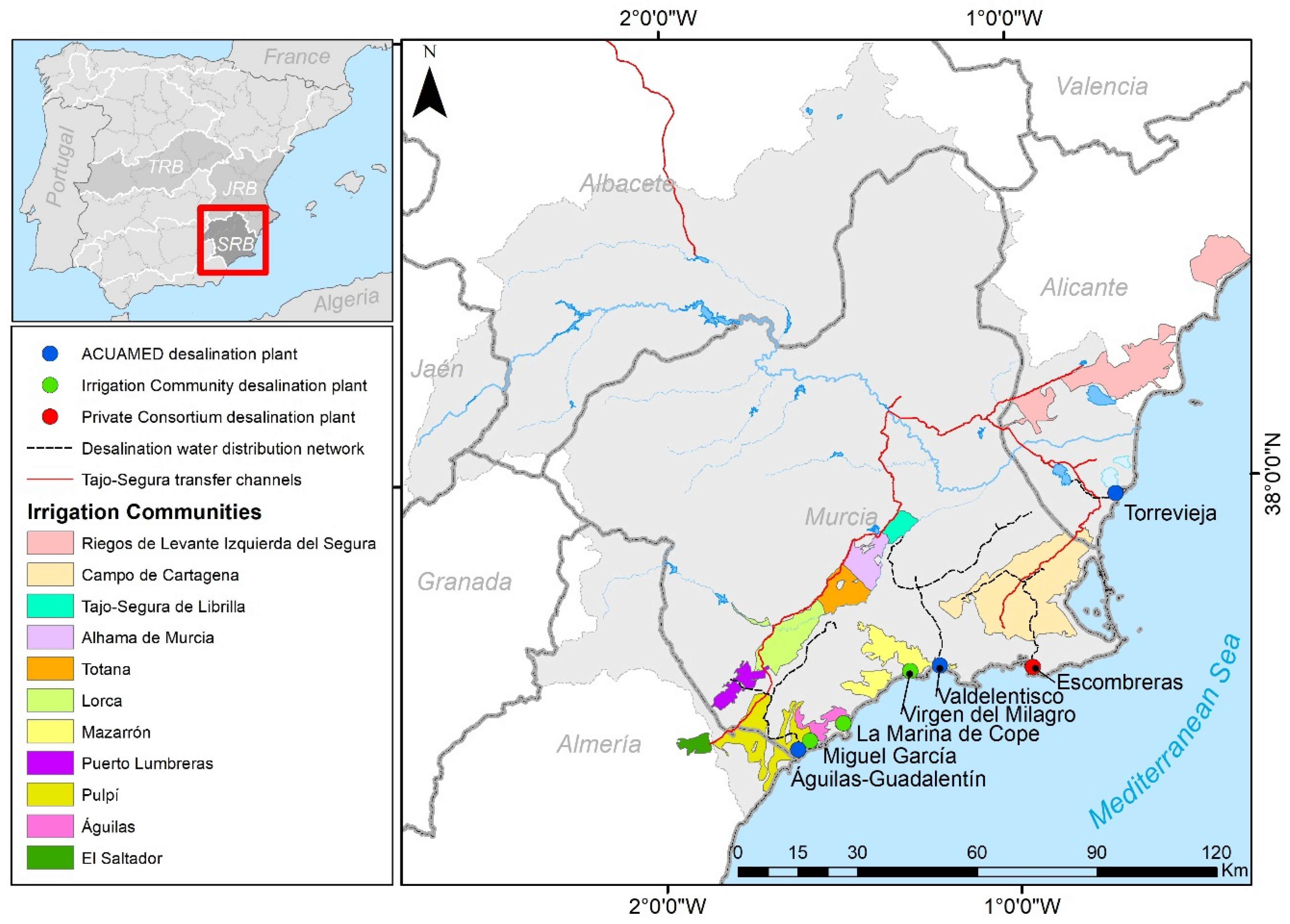
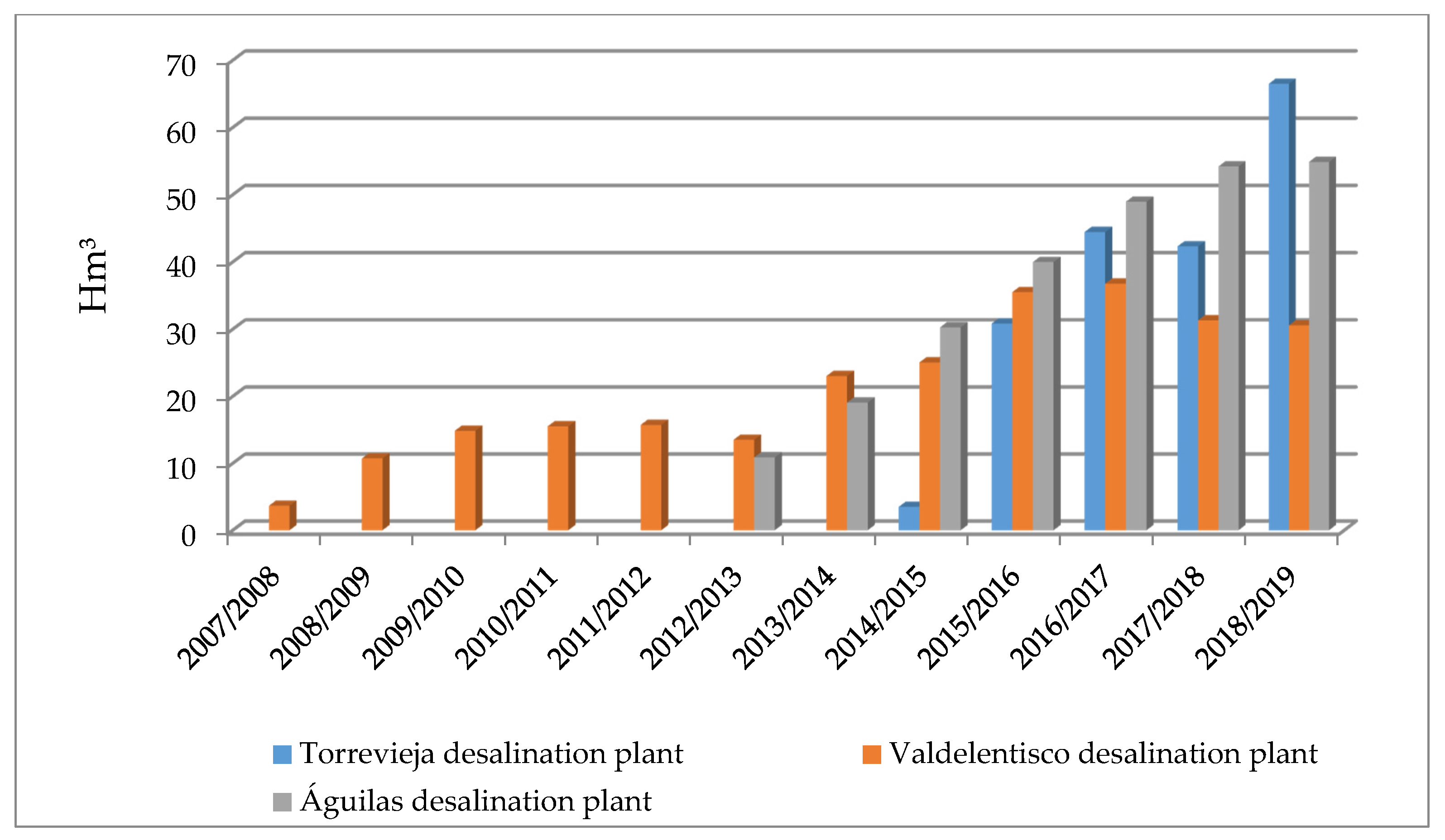
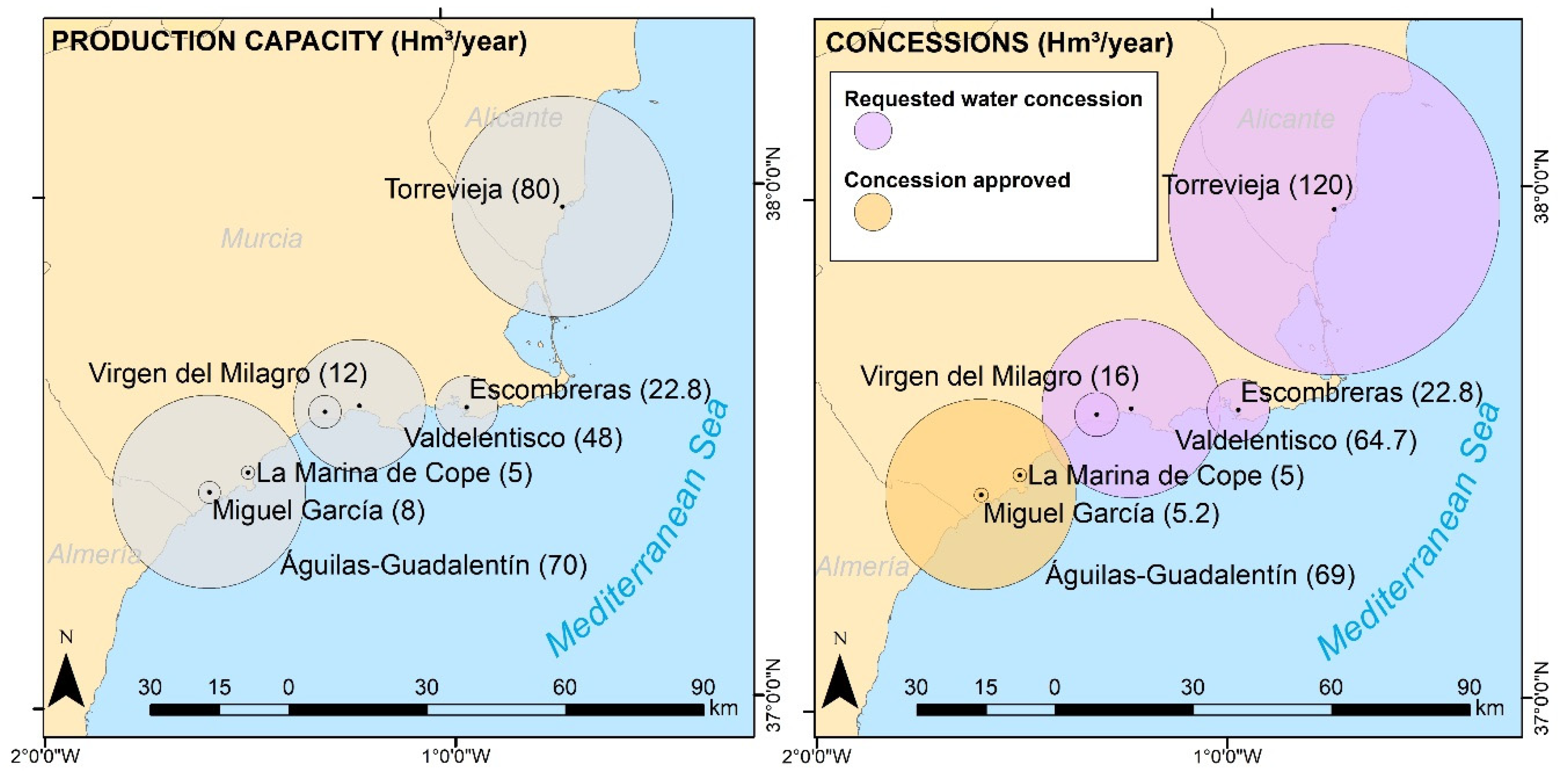
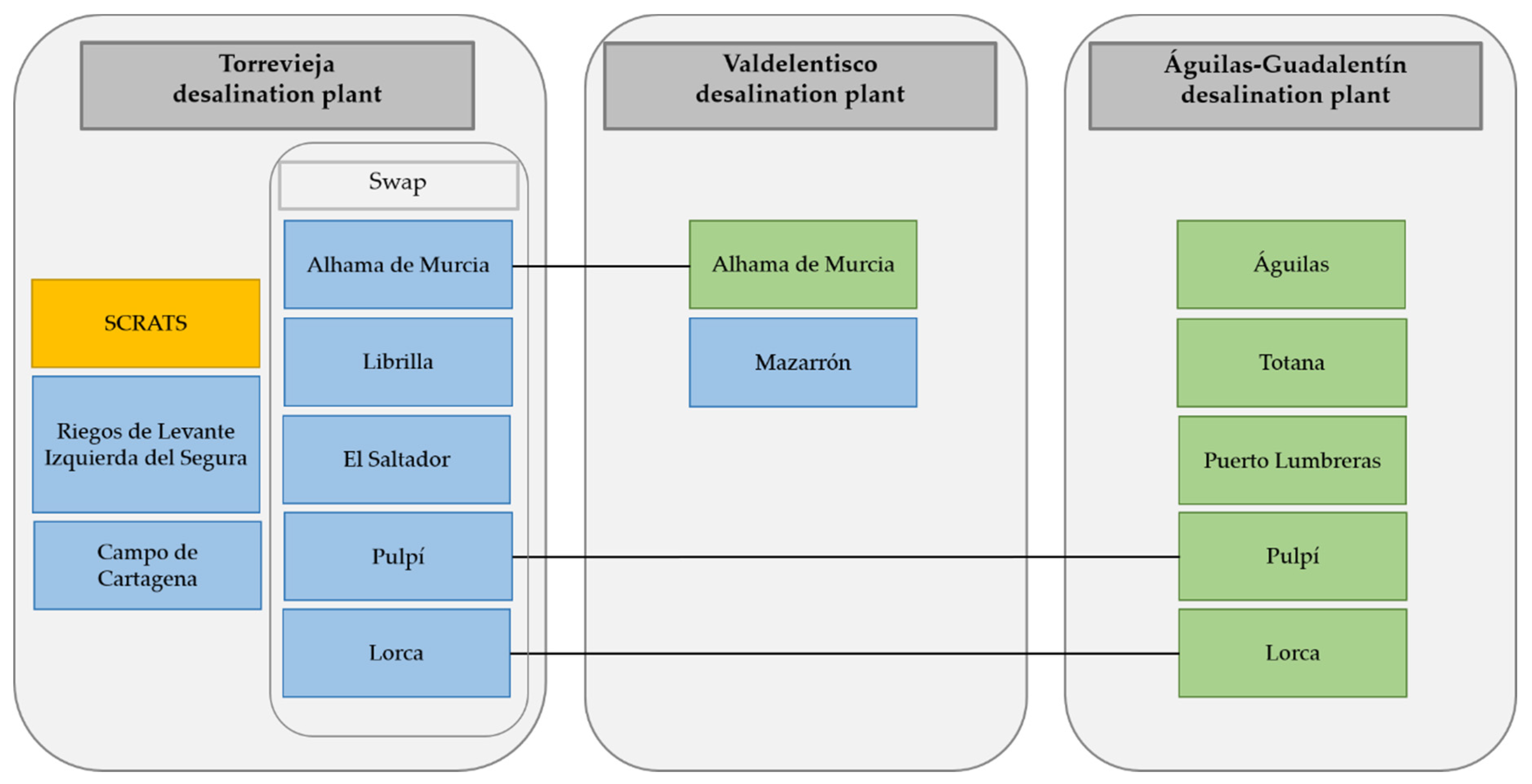
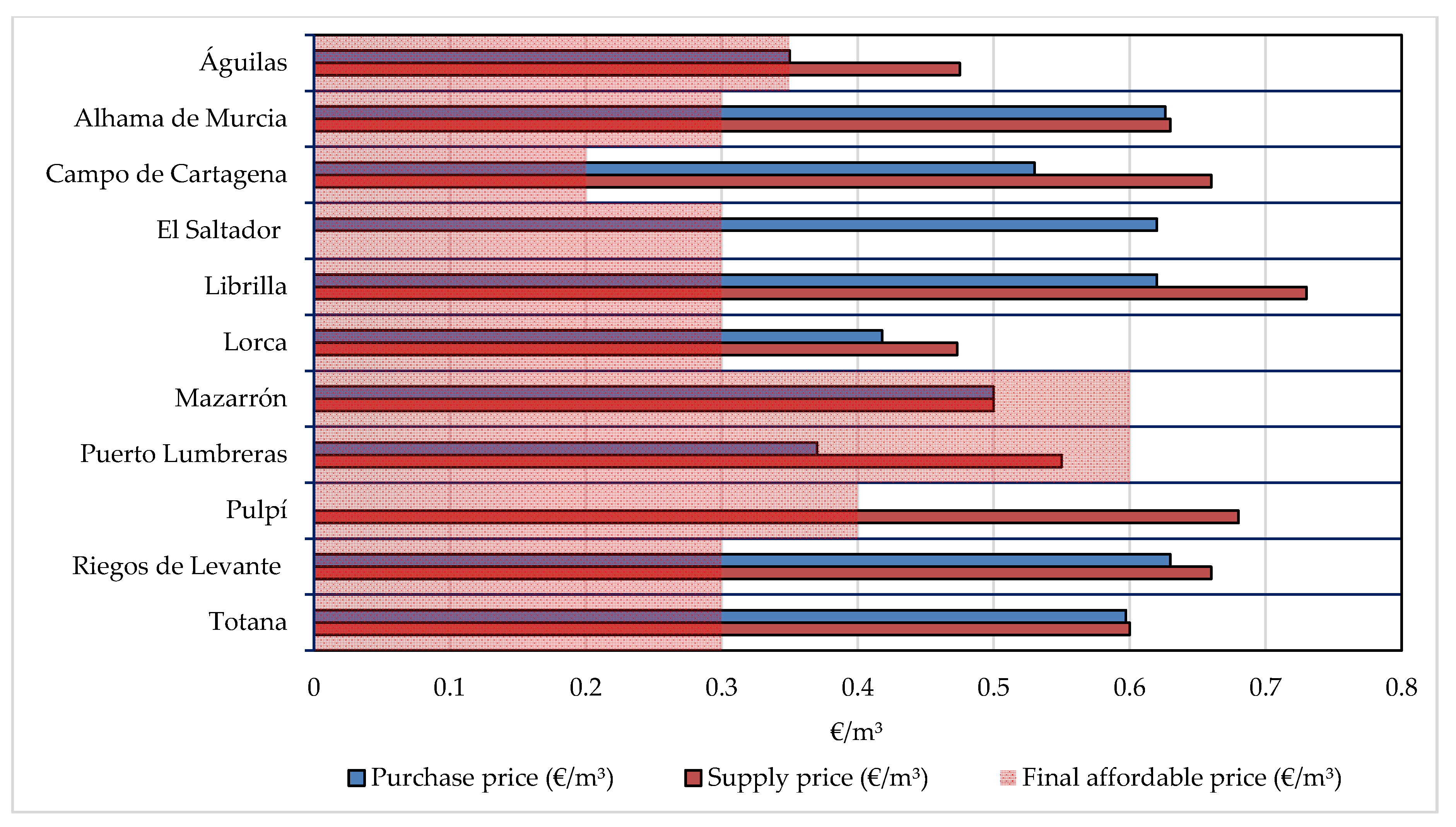
| Irrigation Community | Year | Irrigable Surface | Irrigated Surface | Irrigators | Average Farm Size (ha) | Main Crops 14 | Irrigation Method |
|---|---|---|---|---|---|---|---|
| Águilas | 1991 1 | 6029 | ≈4800 | 1620 | 3 7 | Vegetables and fruits | Drip (100%) |
| Alhama de Murcia | 1976 2 | 7200 | 5096 | 2318 | <1 8 | Fruits and vegetables | Drip (80%) and flood (20%) |
| Campo de Cartagena | 1952 3 | 41,920 | 38,319 5 | 9678 | 4 | Vegetables and fruits | Drip (96%), sprinkler (2%), and flood (2%) |
| El Saltador | 1989 | 2500 | 2300 | ≈1000 | 1.5–4 9 | Vegetables and fruits | Drip (98%) and sprinkler (2%) |
| Librilla | 1979 | 2532 4 | ≈1900 | 1916 | <1 10 | Fruits and vegetables | Drip (40%) and Flood (60%) |
| Lorca | 1978 | 23,905 | 23,905 6 | ≈12,000 | 1.5 | Vegetables and fruits | Drip (80%) and Flood (20%) |
| Mazarrón | 1991 | 4803 | 3595 | 1150 | <1 | Vegetables, vineyards and fruits | Drip (100%) |
| Puerto Lumbreras | 1996 | 4022 | ≈3000 | 880 | 3–4 11 | Vegetables and fruits | Drip (90%), sprinkler (2%), and flood (8%) |
| Pulpí | 1991 | 8451 | ≈7000 | 1239 | 3 12 | Fruits and vegetables | Drip (70%) and Sprinkler (30%) |
| Riegos de Levante Izquierda del Segura | 1991 | ≈26,000 | ≈24,000 | ≈22,000 | 1 | Fruits and vegetables | Drip (45%) and Flood (55%) |
| Totana | 1979 | 10,765 | 6979 | 4216 | <1 13 | Vegetables, fruits and essences | Drip (80%) and Flood (20%) |
| Petitioner (Irrigation Community) | Desalination Plant | Approved Water Concession (hm3/Year) | Water Concession Being Processed (hm3/Year) |
|---|---|---|---|
| Águilas | Águilas-Guadalentín | 16.5 | - |
| Miguel García | 5.3 | - | |
| Alhama de Murcia | Valdelentisco | - | 1 |
| Águilas-Guadalentín | 1.2 | - | |
| Librilla | Valdelentisco | - | 1 |
| Lorca | Águilas-Guadalentín | 25.4 | - |
| Mazarrón | Virgen del Milagro | - | 16 |
| Puerto Lumbreras | Águilas-Guadalentín | 6 | - |
| Pulpí | Águilas-Guadalentín | 6 | - |
| Totana | Valdelentisco | - | 5 |
| Águilas-Guadalentín | 3.3 | - | |
| TST irrigation communities | Torrevieja | - | 80 |
| Total | 64 | 103 |
| Irrigation Community | Concession Water Volume (hm3/Year) | Average Water Volume on Water Withdrawal Points (hm3/Year) | Average Water Volume on Water Withdrawal Points during Droughts (hm3/Year) | Water Demand (hm3/Year) | |||
|---|---|---|---|---|---|---|---|
| Total | D.W. | Total | D.W. | Total | D.W. | ||
| Águilas | 22.8 | 21.5 | 22.8 | 21.5 | 22.8 | 21.5 | 22.8 |
| Alhama de Murcia | 16.9 | 3.3 | 7.1 | 1.6 | 4.5 | 1.6 | 22 |
| Campo de Cartagena | 137.2 | - | 98.8 | 28 | 37 | 14 | 180–200 |
| El Saltador | 16 | 1.5–2 | 5.3 | 3.3 | 2 | 11 | |
| Librilla | 14.5 | 7.2 | 7.4 | 1.35–2 | 2.5–3.8 | 1.5 | 5.5 |
| Lorca | 71.7 | 23 | 50.4 | 23 | 39.4 | 23 | 110.9 |
| Mazarrón | 15.5 | 14 | 15.5 | 14 | 15.5 | 14 | 24 |
| Puerto Lumbreras | 9.4 | 6 | 8.1 | 6 | 7.9–8 | 6 | 14 |
| Pulpí | 32 | 10.9 | 7.6 | 6.5 | 7.6 | 6.5 | 32–35 |
| Riegos de Levante Izquierda del Segura | 167.5 | 11 | The average water volume on withdrawal points is not controlled. Each irrigation community who is part of the General Community is responsible for water distribution. | 45–50 | |||
| Totana | 16.1 | 2.8 | 7.8 | 2.8 | 5.2 | 2.8 | 27 |
| Irrigation Community | Quality Control Systems | Conductivity of D.W. | Perception of D.W. Quality | Problems with Boron |
|---|---|---|---|---|
| Águilas | Yes | 600–700 | Very good | No |
| Alhama de Murcia | Yes | D.K. | Good | No |
| Campo de Cartagena | Yes | 500 | Fair | No |
| El Saltador | No | 500 | Good | No |
| Librilla | Yes | D.K. | Poor | D.K. |
| Lorca | Yes | 400 | Very good | Yes |
| Mazarrón | Yes | 600 | Good | No |
| Puerto Lumbreras | Yes | 500–600 | Good | Yes |
| Pulpí | Yes | 500 | Very Good | Yes |
| Riegos de Levante Izquierda del Segura | No | D.K. | Good | No |
| Totana | Yes | 457 | Good | No |
© 2020 by the authors. Licensee MDPI, Basel, Switzerland. This article is an open access article distributed under the terms and conditions of the Creative Commons Attribution (CC BY) license (http://creativecommons.org/licenses/by/4.0/).
Share and Cite
Ricart, S.; Villar-Navascués, R.; Gil-Guirado, S.; Rico-Amorós, A.M.; Arahuetes, A. How to Close the Gap of Desalinated Seawater for Agricultural Irrigation? Confronting Attitudes between Managers and Farmers in Alicante and Murcia (Spain). Water 2020, 12, 1132. https://doi.org/10.3390/w12041132
Ricart S, Villar-Navascués R, Gil-Guirado S, Rico-Amorós AM, Arahuetes A. How to Close the Gap of Desalinated Seawater for Agricultural Irrigation? Confronting Attitudes between Managers and Farmers in Alicante and Murcia (Spain). Water. 2020; 12(4):1132. https://doi.org/10.3390/w12041132
Chicago/Turabian StyleRicart, Sandra, Rubén Villar-Navascués, Salvador Gil-Guirado, Antonio M. Rico-Amorós, and Ana Arahuetes. 2020. "How to Close the Gap of Desalinated Seawater for Agricultural Irrigation? Confronting Attitudes between Managers and Farmers in Alicante and Murcia (Spain)" Water 12, no. 4: 1132. https://doi.org/10.3390/w12041132
APA StyleRicart, S., Villar-Navascués, R., Gil-Guirado, S., Rico-Amorós, A. M., & Arahuetes, A. (2020). How to Close the Gap of Desalinated Seawater for Agricultural Irrigation? Confronting Attitudes between Managers and Farmers in Alicante and Murcia (Spain). Water, 12(4), 1132. https://doi.org/10.3390/w12041132







